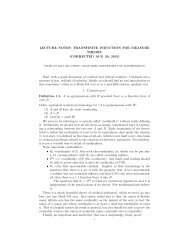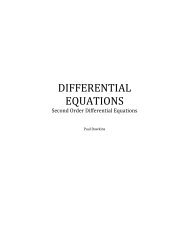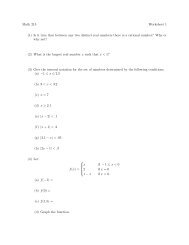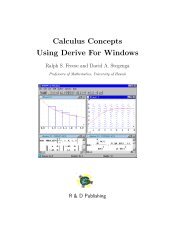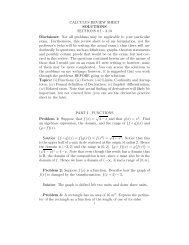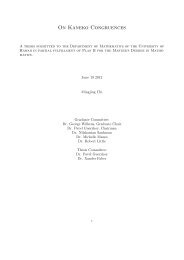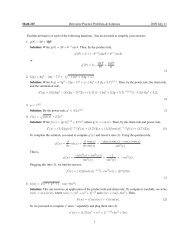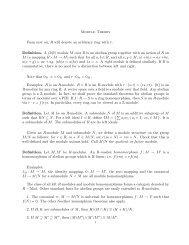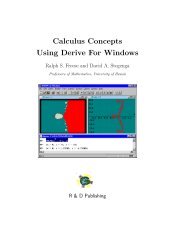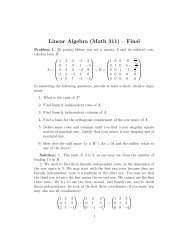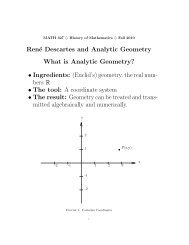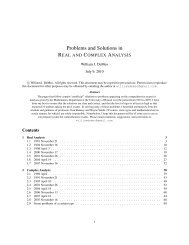- Page 1 and 2: Applied Calculus Math 215 Karl Hein
- Page 3 and 4: Contents Preface iii 0 A Preview 1
- Page 5 and 6: Preface These notes are written for
- Page 7 and 8: need the powerful machine developed
- Page 9 and 10: Chapter 0 A Preview In this introdu
- Page 11 and 12: scrutiny, you detect that the graph
- Page 13 and 14: 0.8 0.6 0.4 0.2 -0.2 R(t) 1 2 3 4 t
- Page 15 and 16: Chapter 1 Some Background Material
- Page 17 and 18: 1.1. LINES 9 In application, we are
- Page 19 and 20: 1.1. LINES 11 Exercise 3. Suppose a
- Page 21 and 22: 1.2. PARABOLAS AND HIGHER DEGREE PO
- Page 23 and 24: 1.2. PARABOLAS AND HIGHER DEGREE PO
- Page 25 and 26: 1.2. PARABOLAS AND HIGHER DEGREE PO
- Page 27 and 28: 1.2. PARABOLAS AND HIGHER DEGREE PO
- Page 29: 1.3. THE EXPONENTIAL AND LOGARITHM
- Page 33 and 34: 1.3. THE EXPONENTIAL AND LOGARITHM
- Page 35 and 36: 1.3. THE EXPONENTIAL AND LOGARITHM
- Page 37 and 38: 1.3. THE EXPONENTIAL AND LOGARITHM
- Page 39 and 40: 1.4. USE OF GRAPHING UTILITIES 31 E
- Page 41 and 42: 1.4. USE OF GRAPHING UTILITIES 33 a
- Page 43 and 44: Chapter 2 The Derivative The deriva
- Page 45 and 46: straight line. There is still a dif
- Page 47 and 48: 6 4 2 -2 -1 1 2 -2 -4 Figure 2.3: E
- Page 49 and 50: Figure 2.4: The radial line is perp
- Page 51 and 52: 2.1. DEFINITION OF THE DERIVATIVE 4
- Page 53 and 54: 2.1. DEFINITION OF THE DERIVATIVE 4
- Page 55 and 56: 2.2. DIFFERENTIABILITY AS A LOCAL P
- Page 57 and 58: 2.3. DERIVATIVES OF SOME BASIC FUNC
- Page 59 and 60: 2.3. DERIVATIVES OF SOME BASIC FUNC
- Page 61 and 62: 2.3. DERIVATIVES OF SOME BASIC FUNC
- Page 63 and 64: 2.3. DERIVATIVES OF SOME BASIC FUNC
- Page 65 and 66: 2.4. SLOPES OF SECANT LINES AND RAT
- Page 67 and 68: 2.4. SLOPES OF SECANT LINES AND RAT
- Page 69 and 70: 2.5. UPPER AND LOWER PARABOLAS 61 o
- Page 71 and 72: 2.5. UPPER AND LOWER PARABOLAS 63 6
- Page 73 and 74: 2.5. UPPER AND LOWER PARABOLAS 65 2
- Page 75 and 76: 2.5. UPPER AND LOWER PARABOLAS 67 I
- Page 77 and 78: 2.6. OTHER NOTATIONS FOR THE DERIVA
- Page 79 and 80: 2.7. EXPONENTIAL GROWTH AND DECAY 7
- Page 81 and 82:
2.7. EXPONENTIAL GROWTH AND DECAY 7
- Page 83 and 84:
2.7. EXPONENTIAL GROWTH AND DECAY 7
- Page 85 and 86:
2.8. MORE EXPONENTIAL GROWTH AND DE
- Page 87 and 88:
2.8. MORE EXPONENTIAL GROWTH AND DE
- Page 89 and 90:
2.9. DIFFERENTIABILITY IMPLIES CONT
- Page 91 and 92:
2.10. BEING CLOSE VERSUS LOOKING LI
- Page 93 and 94:
2.11. RULES OF DIFFERENTIATION 85 t
- Page 95 and 96:
2.11. RULES OF DIFFERENTIATION 87 2
- Page 97 and 98:
2.11. RULES OF DIFFERENTIATION 89 E
- Page 99 and 100:
2.11. RULES OF DIFFERENTIATION 91 2
- Page 101 and 102:
2.11. RULES OF DIFFERENTIATION 93 f
- Page 103 and 104:
2.11. RULES OF DIFFERENTIATION 95 I
- Page 105 and 106:
2.11. RULES OF DIFFERENTIATION 97 T
- Page 107 and 108:
2.11. RULES OF DIFFERENTIATION 99 E
- Page 109 and 110:
2.11. RULES OF DIFFERENTIATION 101
- Page 111 and 112:
2.11. RULES OF DIFFERENTIATION 103
- Page 113 and 114:
2.11. RULES OF DIFFERENTIATION 105
- Page 115 and 116:
2.11. RULES OF DIFFERENTIATION 107
- Page 117 and 118:
2.11. RULES OF DIFFERENTIATION 109
- Page 119 and 120:
2.12. IMPLICIT DIFFERENTIATION 111
- Page 121 and 122:
2.12. IMPLICIT DIFFERENTIATION 113
- Page 123 and 124:
2.13. RELATED RATES 115 Exercise 80
- Page 125 and 126:
2.13. RELATED RATES 117 Exercise 86
- Page 127 and 128:
2.14. NUMERICAL METHODS 119 Your ca
- Page 129 and 130:
2.14. NUMERICAL METHODS 121 There i
- Page 131 and 132:
2.14. NUMERICAL METHODS 123 n xn f(
- Page 133 and 134:
2.14. NUMERICAL METHODS 125 Practic
- Page 135 and 136:
2.14. NUMERICAL METHODS 127 Solutio
- Page 137 and 138:
2.14. NUMERICAL METHODS 129 t y(t)
- Page 139 and 140:
2.14. NUMERICAL METHODS 131 stabili
- Page 141 and 142:
2.14. NUMERICAL METHODS 133 peratur
- Page 143 and 144:
2.15. SUMMARY 135 • Quotient rule
- Page 145 and 146:
Chapter 3 Applications of the Deriv
- Page 147 and 148:
3.2. CAUCHY’S MEAN VALUE THEOREM
- Page 149 and 150:
3.2. CAUCHY’S MEAN VALUE THEOREM
- Page 151 and 152:
3.2. CAUCHY’S MEAN VALUE THEOREM
- Page 153 and 154:
3.3. THE FIRST DERIVATIVE AND MONOT
- Page 155 and 156:
3.3. THE FIRST DERIVATIVE AND MONOT
- Page 157 and 158:
3.3. THE FIRST DERIVATIVE AND MONOT
- Page 159 and 160:
3.3. THE FIRST DERIVATIVE AND MONOT
- Page 161 and 162:
3.3. THE FIRST DERIVATIVE AND MONOT
- Page 163 and 164:
3.4. THE SECOND AND HIGHER DERIVATI
- Page 165 and 166:
3.5. THE SECOND DERIVATIVE AND CONC
- Page 167 and 168:
3.5. THE SECOND DERIVATIVE AND CONC
- Page 169 and 170:
3.5. THE SECOND DERIVATIVE AND CONC
- Page 171 and 172:
3.5. THE SECOND DERIVATIVE AND CONC
- Page 173 and 174:
3.6. LOCAL EXTREMA AND INFLECTION P
- Page 175 and 176:
3.7. THE FIRST DERIVATIVE TEST 167
- Page 177 and 178:
3.7. THE FIRST DERIVATIVE TEST 169
- Page 179 and 180:
3.8. THE SECOND DERIVATIVE TEST 171
- Page 181 and 182:
3.9. EXTREMA OF FUNCTIONS 173 and a
- Page 183 and 184:
3.9. EXTREMA OF FUNCTIONS 175 200 1
- Page 185 and 186:
3.9. EXTREMA OF FUNCTIONS 177 P (25
- Page 187 and 188:
3.9. EXTREMA OF FUNCTIONS 179 We le
- Page 189 and 190:
3.9. EXTREMA OF FUNCTIONS 181 We de
- Page 191 and 192:
3.10. DETECTION OF INFLECTION POINT
- Page 193 and 194:
3.10. DETECTION OF INFLECTION POINT
- Page 195 and 196:
3.11. OPTIMIZATION PROBLEMS 187 3 2
- Page 197 and 198:
3.11. OPTIMIZATION PROBLEMS 189 sha
- Page 199 and 200:
3.11. OPTIMIZATION PROBLEMS 191 is
- Page 201 and 202:
3.11. OPTIMIZATION PROBLEMS 193 (
- Page 203 and 204:
3.11. OPTIMIZATION PROBLEMS 195 or
- Page 205 and 206:
3.11. OPTIMIZATION PROBLEMS 197 Exe
- Page 207 and 208:
3.12. SKETCHING GRAPHS 199 is conca
- Page 209 and 210:
3.12. SKETCHING GRAPHS 201 The valu
- Page 211 and 212:
Chapter 4 Integration We will intro
- Page 213 and 214:
0.6 0.5 0.4 0.3 0.2 0.1 1 2 3 4 5 6
- Page 215 and 216:
4.1. UPPER AND LOWER SUMS 207 So, i
- Page 217 and 218:
4.1. UPPER AND LOWER SUMS 209 1.25
- Page 219 and 220:
4.1. UPPER AND LOWER SUMS 211 4 3 2
- Page 221 and 222:
4.2. INTEGRABILITY AND AREAS 213 4.
- Page 223 and 224:
4.2. INTEGRABILITY AND AREAS 215 Pr
- Page 225 and 226:
4.2. INTEGRABILITY AND AREAS 217 th
- Page 227 and 228:
4.3. SOME ELEMENTARY OBSERVATIONS 2
- Page 229 and 230:
4.3. SOME ELEMENTARY OBSERVATIONS 2
- Page 231 and 232:
4.4. INTEGRABLE FUNCTIONS 223 4.4 I
- Page 233 and 234:
4.5. ANTI-DERIVATIVES 225 In this e
- Page 235 and 236:
4.6. THE FUNDAMENTAL THEOREM OF CAL
- Page 237 and 238:
4.6. THE FUNDAMENTAL THEOREM OF CAL
- Page 239 and 240:
4.6. THE FUNDAMENTAL THEOREM OF CAL
- Page 241 and 242:
4.6. THE FUNDAMENTAL THEOREM OF CAL
- Page 243 and 244:
4.7. SUBSTITUTION 235 We explain th
- Page 245 and 246:
4.7. SUBSTITUTION 237 Solution: We
- Page 247 and 248:
4.7. SUBSTITUTION 239 The first ide
- Page 249 and 250:
4.7. SUBSTITUTION 241 u = π/2. (Fo
- Page 251 and 252:
4.8. AREAS BETWEEN GRAPHS 243 x-coo
- Page 253 and 254:
4.9. NUMERICAL INTEGRATION 245 In a
- Page 255 and 256:
4.9. NUMERICAL INTEGRATION 247 In t
- Page 257 and 258:
4.9. NUMERICAL INTEGRATION 249 an a
- Page 259 and 260:
4.10. APPLICATIONS OF THE INTEGRAL
- Page 261 and 262:
4.10. APPLICATIONS OF THE INTEGRAL
- Page 263 and 264:
4.11. THE EXPONENTIAL AND LOGARITHM
- Page 265 and 266:
4.11. THE EXPONENTIAL AND LOGARITHM
- Page 267 and 268:
4.11. THE EXPONENTIAL AND LOGARITHM
- Page 269 and 270:
4.11. THE EXPONENTIAL AND LOGARITHM
- Page 271 and 272:
Chapter 5 Prerequisites from Precal
- Page 273 and 274:
5.1. THE REAL NUMBERS 265 A typical
- Page 275 and 276:
5.2. INEQUALITIES AND ABSOLUTE VALU
- Page 277 and 278:
5.3. FUNCTIONS, DEFINITION AND NOTA
- Page 279 and 280:
5.3. FUNCTIONS, DEFINITION AND NOTA
- Page 281 and 282:
5.3. FUNCTIONS, DEFINITION AND NOTA
- Page 283 and 284:
5.4. GRAPHING EQUATIONS 275 Example
- Page 285 and 286:
5.5. TRIGONOMETRIC FUNCTIONS 277 1
- Page 287 and 288:
5.5. TRIGONOMETRIC FUNCTIONS 279 40
- Page 289 and 290:
5.5. TRIGONOMETRIC FUNCTIONS 281 op
- Page 291 and 292:
5.5. TRIGONOMETRIC FUNCTIONS 283 an
- Page 293 and 294:
5.5. TRIGONOMETRIC FUNCTIONS 285 A
- Page 295 and 296:
5.6. INVERSE FUNCTIONS 287 Observe
- Page 297 and 298:
5.6. INVERSE FUNCTIONS 289 5 4 3 2
- Page 299 and 300:
5.6. INVERSE FUNCTIONS 291 Exercise
- Page 301 and 302:
5.7. NEW FUNCTIONS FROM OLD ONES 29




